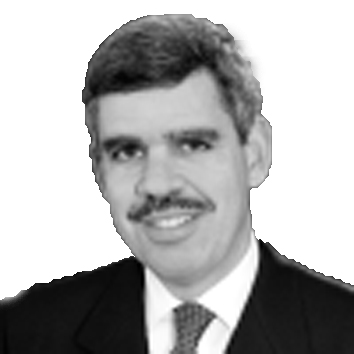The Inflation Catch-Up Game

Mohamed A. El-Erian
Inflation is now on the front page of newspapers around the world, and for good reason. Prices of more and more goods and services are increasing in a manner not seen for decades. This inflationary spike, accompanied by actual and feared supply shortages, is fueling both consumer and producer anxiety. By also threatening to worsen inequality and derail a much-needed sustained and inclusive economic recovery from the COVID-19 pandemic, it is also becoming a hot political issue.
For their part, policymakers at central banks in the United Kingdom and the United States have started to move away from the narrative of “transitory” inflation. But the pivot is far from complete and not nearly quick enough, particularly at the US Federal Reserve, the world’s most powerful and systemically important monetary institution. Delays in Congress approving measures to increase productivity and enhance labour-force participation are not helping, either.
Buoyant demand
The reasons for the rise in inflation are well known. Buoyant demand is encountering inadequate supply – a result of disrupted transportation and supply chains, labour shortages, and an energy squeeze.
While notable, this price surge does not herald a return to a 1970s scenario of double-digit inflation rates. Rigid cost-price indexing is rarer these days. Initial conditions regarding the formation of inflationary expectations are a lot less unstable. And central banks’ credibility is much higher, although it is currently facing its severest test in decades.
But inflation will nonetheless be much more pronounced than top Fed officials had thought when they repeatedly dismissed increasing price pressures as a temporary phenomenon. Even today, their inflation forecasts – despite having been revised up several times already – still underestimate what lies ahead.
Survey-based inflation expectations compiled by the New York Federal Reserve have risen above four per cent on both a one- and three-year time horizon. Knock-on cost-push inflation tendencies are broadening. Quit rates among US workers are at record highs as employees feel more comfortable leaving their jobs to seek better-paying positions or strike a better work-life balance. There is more talk of labour strikes. And all of this is exacerbated by consumers and firms bringing forward future demand, mainly in response to concerns about product shortages and rising prices.
The current bout of inflation is part of a general structural change in the global macroeconomic paradigm. We have gone from a situation of deficient aggregate demand to one in which demand is fine overall. Notably, US retail sales increased by a higher-than-expected 13.9 per cent year on year in September, indicating that there are still quite a few pockets of pent-up purchasing power being translated into effective demand.
Of course, this is not to say that there are no issues regarding the composition of demand that must be addressed. Inequality, not just of income and wealth but also of opportunity, remains an urgent concern.
Higher and more persistent inflation underscores such concerns, because its implications are multifaceted – economic, financial, institutional, political, and social. Those effects will prove increasingly uneven in their impact, hitting the poor especially hard. Globally, the fallout from the inflationary surge risks knocking some lower-income developing countries off a secular path of economic convergence.
All this makes it even more important for the Fed and Congress to act promptly to ensure that the current inflationary phase does not end up unnecessarily undermining economic growth, increasing inequality, and fueling financial instability. A marked reduction in monetary stimulus, still operating in hyper-emergency mode, is needed, notwithstanding the unlucky timing that governs the shift to the Fed’s new policy framework. And US lawmakers can assist by moving more forcefully on supply-enhancing initiatives, for both capital and labour, that fall squarely in their domain.
Prudential regulation
Policymakers should also strengthen prudential regulation and supervision of the financial sector, especially the non-bank system. And, given the greater pressures on corporate profit margins and the superior ability of large firms to navigate supply disruptions, they will need to keep a close eye on firm concentration.
It is good news that, after initially and persistently misreading US inflation dynamics, more Fed officials are now starting to come to grips with the situation. The Fed would be well advised to catch up even faster. Otherwise, it will end up in the midst of a blame game that will further erode policy credibility and undermine its political standing.
(Mohamed, President of Queens’ College, University of Cambridge, is a former chairman of US President Barack Obama’s Global Development Council. He was named one of Foreign Policy’s Top 100 Global Thinkers four years running.)
-- Project Syndicate
Recent News

Do not make expressions casting dout on election: EC
14 Apr, 2022
CM Bhatta says may New Year 2079 BS inspire positive thinking
14 Apr, 2022
Three new cases, 44 recoveries in 24 hours
14 Apr, 2022
689 climbers of 84 teams so far acquire permits for climbing various peaks this spring season
14 Apr, 2022
How the rising cost of living crisis is impacting Nepal
14 Apr, 2022
US military confirms an interstellar meteor collided with Earth
14 Apr, 2022
Valneva Covid vaccine approved for use in UK
14 Apr, 2022
Chair Prachanda highlights need of unity among Maoist, Communist forces
14 Apr, 2022
Ranbir Kapoor and Alia Bhatt: Bollywood toasts star couple on wedding
14 Apr, 2022
President Bhandari confers decorations (Photo Feature)
14 Apr, 2022











